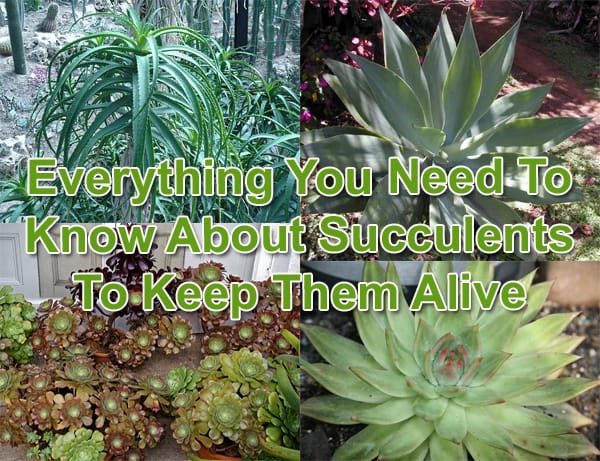Newsletter Articles
The Succulent Handbook – Everything You Need To Know About Succulents To Keep Them Alive
Written by Susan B.
Our moderate Southern California climate makes it possible to enjoy garden plants all year long. You may believe that it’s not possible to have a beautiful-looking landscape unless you devote every free minute to maintaining it. And while that may be the case with some plants, it’s not the case with all plants. With succulents, you can have your cake and eat it, too, because they’re adapted to thriving with minimal care.
What Are Succulents?
Succulents are plants that have thick leaves or stems that they use to store water. Cacti are types of succulents because they possess this characteristic. The sharp spines on cactus plants are the feature that distinguishes them from other succulents.
There are roughly 50-60 plant families that contain at least one succulent species. The largest of these plant families are the cactus and ice plant families, each of which consists of around 2,000 varieties. The combination of species from these two families along make up nearly 40% of all known succulents. Joe Clements, the Arboretum manager at Pitzer College in Claremont California, estimates that a total of 20,000 succulent varieties from all plant genera exist today.
Succulents to Grow in Southern California
- Aloe arborescens
This variety of aloe is known for its fire resistance. When grown near the coast, it can survive without water (other than rainwater.) Eventually, this plant will reach a height of 9 feet. It produces spikey rosette formations from leaves. Ultimately, it may spread to 18 inches. The color of the leaves varies with different levels of sun exposure. Plants produce bright red flowers that grow off of two-inch spikes. The flowers bloom throughout the fall and early winter.
-
Agave attenuata
Agave is a popular succulent for Southern California gardens. This fast and prolific grower can spread to a six-foot-wide mass. Fortunately, they are easy to divide. So you can transplant the divisions elsewhere on your property. Agave will not survive temperatures that drop below 30 degrees. But they tolerate clay soil. You can grow agave in containers with occasional watering.
-
Aeonium arboreum
Dark-colored varieties are known as Aeonium schwarzkopf and Aeonium atropurpureum. Its spoon-shaped leaves form round rosettes that grow off of otherwise bare stems. It grows well in full sun or part shade. It likes deep but infrequent watering. This species reaches two to three feet in height and equal in width.
-
Echeveria agavoides
Lipstick Echeveria gets its common name from the red leaf tips. This compact plant has rosettes that grow to a foot wide. It produces pups from runners on the ground. It needs to grow in soil that drains well because it won’t tolerate being overwatered.
Foolproof Care Tips for Succulents
- Give Your Succulents Room to Breathe
Avoid planting succulents too close to one another. Doing so hinders airflow, but it also makes it hard to see insect or pest damage, or evidence of diseases.
- Choose the Proper Growing Medium
Succulents need fast-draining soil to prevent roots from sitting in water. For succulents grown in the ground, add sand and ground-up pumice to improve drainage. For container-grown plants, choose a cactus or succulent mix. If you prefer to make your growing medium, add crushed lava, perlite, or pumice to ordinary potting soil.
- Make Sure Containers Have Drainage Holes
If you’re growing succulents in containers, always choose pots that have drainage holes – unless you can add the holes before using them. Drainage holes are the key to ensuring that succulent roots won’t sit in water.
- Drought-Tolerant Isn’t Synonymous With No Water Requirements
Overwatering is the likely reason for succulent deaths. Succulents can survive without water for prolonged periods, but their fat and fleshy leaves will flatten and droop when they need water. If you aren’t sure about when to water your succulents, stick your finger in the soil. If the soil is dry as far as you can feel, then they will benefit from a drink of water. If it’s sweltering outside, you may need to water them more often than you would during colder weather.
- Don’t Forget to Feed Your Succulents
Both container-grown succulents and plants that grow in the ground benefit from a once-yearly dose of fertilizer. Use an all-purpose organic fertilizer and use half of the recommended dosage, so the roots don’t get burned. The best time to feed your succulents is at the start of the growing season.
- Most Succulents Won’t Root in Water
The reason that leaves and stems of succulents won’t root in water is because they already hold water. Allow the broken off leaf or stem to rest in a dry place for at least three days. This resting period lets the “wound” heal before it forms a callus. Allowing the base of the leaf or branch to develop a callus will prevent it from rotting before it roots. Dip the leaf or stem in a rooting hormone and plant it in cactus and succulent mix.
We encourage you to think about adding succulents to your landscape plantings. You can also grow them in containers on your patio, deck, balcony, or porch. Come in and check out our selection of succulents. Our inventory is always changing, so if you want a particular plant, call to see if we have it in stock. Our garden experts are eager to help you fill your home and garden with flowering and green succulents.
Do you like what you see? Sign up for our weekly newsletter to get content like this every week!

